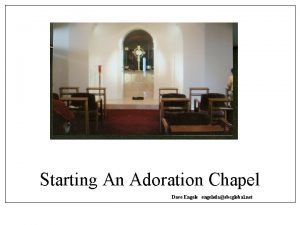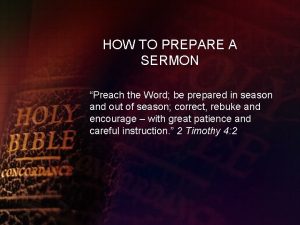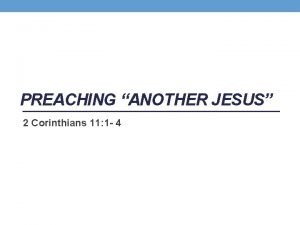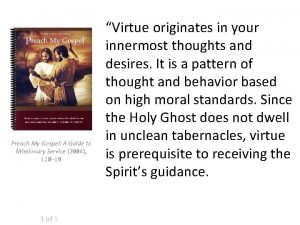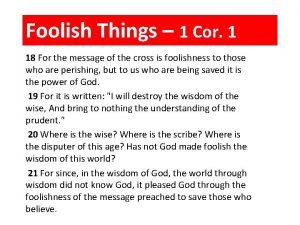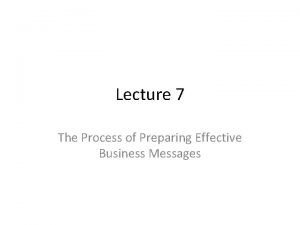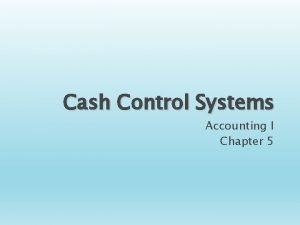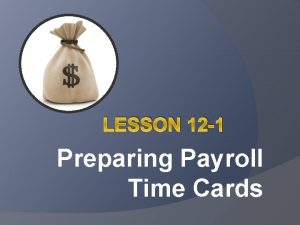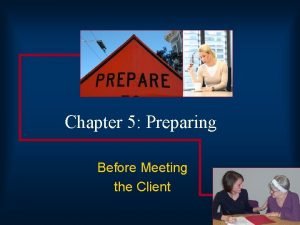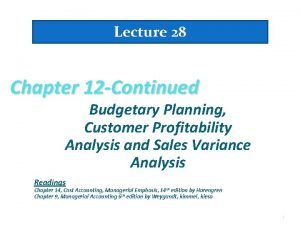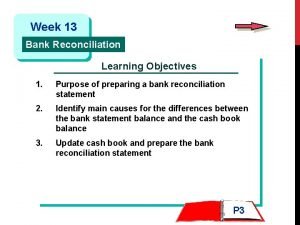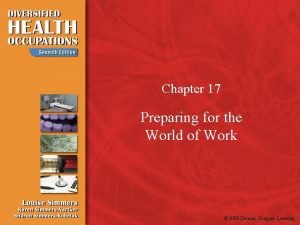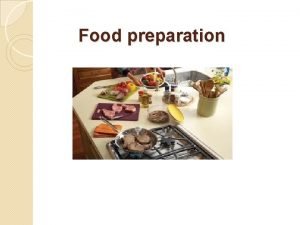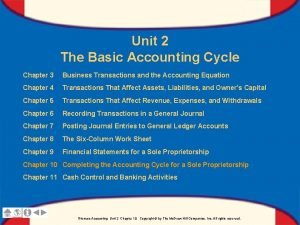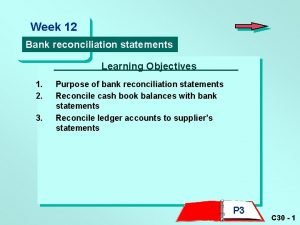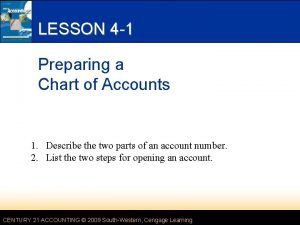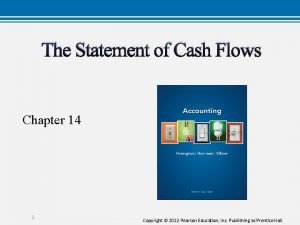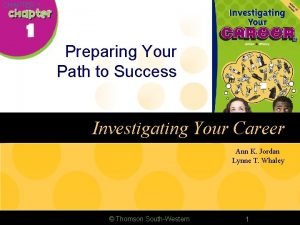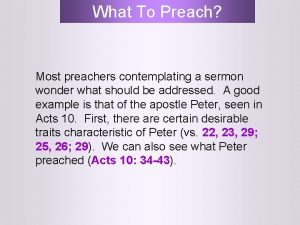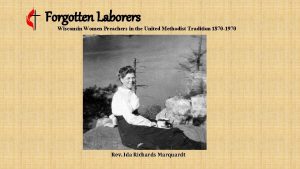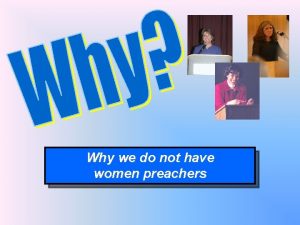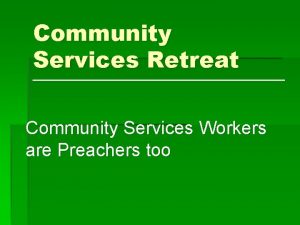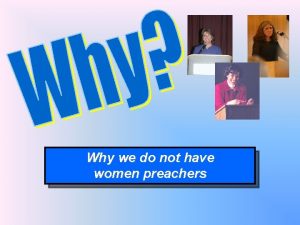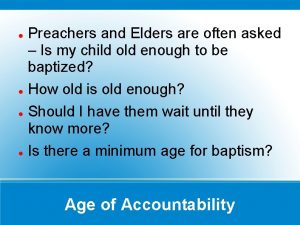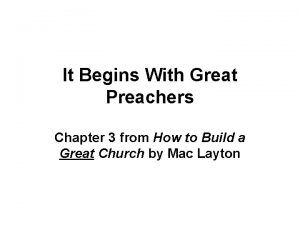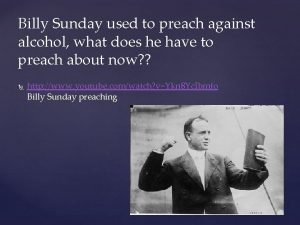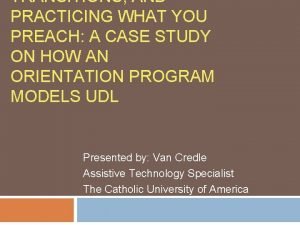Preparing to Preach Preachers Workshop Preparing to Preach














































- Slides: 46


Preparing to Preach

Preachers’ Workshop

Preparing to Preach

The divine dimension in preaching For we know, brothers loved by God, that he has chosen you, because our gospel came to you not simply with words, but also with power, with the Holy Spirit and with deep conviction. (1 Thessalonians 1: 4 -5)

The human dimension in preaching We proclaim him, admonishing and teaching everyone with all wisdom, so that we may present everyone perfect in Christ. To this end I labour, struggling with all his energy, which so powerfully works in me. (Colossians 1: 28 -29)

The preacher’s privilege “It is an enormous privilege to be called to preach in the contemporary world, and to be a Biblical expositor! For one stands in the pulpit with God’s Word in his hands, God’s Spirit in his heart, God’s people before his eyes, waiting expectantly for God’s voice to be heard and obeyed. ” John R. W. Stott, “Christian Preaching in the Contemporary World, ” Bibliotheca Sacra 145: 580 (October-December 1988): 370

Speeches still matter, even in a technological age. The act of persuasion is ubiquitous in professional life and very many people need to master it. The act of making a speech is a medium that has remained essentially unchanged through the ages…. Against all the expectations and regular predictions of its demise, public speech still counts. It always will and it is a skill that needs to be mastered. For full review see “Recommended reading from a surprising source” www. unashamedworkman. org

PREPARING TO PREACH

PREPARING TO PREACH The preparation of the preacher "The greatest need of my people is my personal holiness. ” "Study universal holiness of life. Your whole usefulness depends on this, for your sermons last but an hour or two; your life preaches all the week…. Give yourself to prayer, and get your texts, your thoughts, your words from God. ” Robert Murray M’Cheyne (1813 -1843)

THE PREPARATION OF THE SERMON Three important stages 1. Choosing the subject 2. Doing the spade-work 3. Creating the sermon

STAGE 1. Choosing the subject “And, Father, I ask Thee now for a good text to accompany this fantastic story. ”

STAGE 1. Choosing the subject Locate the text in its context “A text without a context is a pretext for a prooftext” (D. A. Carson) • in the Bible story-line

STAGE 1. Choosing the subject The story of the Bible • a perfect world • a fallen world • a redeemed world • a restored world

STAGE 1: Choosing the subject A text Romans 6: 23 For the wages of sin is death, but the gift of God is eternal life in Christ Jesus our Lord. Romans 6: 15 -23 A topic “Overcoming pride” “Baptism”

STAGE 1. Choosing the subject A single sermon Jonah 1: 4 -6 (“When God sends a storm”) A sermon series Studies in the Book of Jonah (“Running away from the Lord”) “Seven deadly sins”

STAGE 1. Choosing the subject Some advantages of systematic expository preaching: 1. 2. 3. 4. 5. 6. I focus on what God wants to say – not what I want to say. I preach from all of Scripture – not just the parts I prefer. I give people a balanced diet not just their “favourite food”. I deepen my dependence on God – not relying on previous knowledge. I have a plan for preaching – not just wondering what to preach week. I preach Scripture in context – not in isolation.


STAGE 1. Choosing the subject Factors determining how and what you preach: the profile of the congregation • age and gender • the level of literacy/education • length of attendance in the church • the level of Biblical literacy • the degree of Christian commitment/understanding KNOW YOUR AUDIENCE!

STAGE 1. Choosing the subject Factors determining how and what you preach: the worldview of the hearer Cultural changes in Britain: 40 years ago, students asked, “Is it true? ” 20 years ago, students asked, “Does it work? ” today, students ask, “How does it feel? ” “How do you reach a culture which hears with its eyes and sees with its emotions? ” (Ravi Zacharias)

STAGE 2. Doing the spade-work Goal – to discover • what the original author intended to communicate • what God by his Spirit intended to communicate through the human voice/pen of the author Above all, you must understand that no prophecy of Scripture came about by the prophet's own interpretation. For prophecy never had its origin in the will of man, but men spoke from God as they were carried along by the Holy Spirit. (2 Peter 1: 20 -21)

STAGE 2. Doing the spade-work Two important questions: 1. What does it mean? (explanation) 2. What must I/we do? (application) in this order!

STAGE 2. Doing the spade-work Research/study: 1. Different Bible translations • from literal (text) • to idiomatic (meaning) 2. Books (plus media) • from commentaries • to sermons

STAGE 2. Doing the spade-work Making the connection “The great tragedy in the church today is that evangelicals are biblical but not contemporary, while liberals are contemporary but not Biblical. We need faithfulness to the ancient word and sensitivity to the modern world. ”

Preaching that Connects The World of the Bible The World of Today

STAGE 3. Creating the sermon Four goals: 1. A title 2. An introduction 3. A structure 4. A conclusion

STAGE 3. Creating the sermon – a title Three characteristics of a good title • summarises main point • memorable • “attractive” e. g. Luke 8: 40 -48 “Woman with haemorrhage” “Hoping for healing” What is your speech essentially about? Tell me in a single sentence. If you can’t do that, you don’t know. And if you don’t know you aren’t ready to do a speech. (Philip Collins)

STAGE 3. Creating the sermon – an introduction If you don’t strike oil in the first five minutes, stop boring!

STAGE 3. Creating the sermon – an introduction Three characteristics • catches the attention • introduces theme • leads into the title Creativity! Accuracy!

“I am not and have never been a typical Welsh preacher. I felt that in preaching the first thing that you had to do was to demonstrate to the people that what you were going to do was very relevant and urgently important. The Welsh style of preaching started with a verse and the preacher then told you the connection and analysed the words, but the man of the world did not know what he was talking about and was not interested. ”

“I started with the man whom I wanted to listen, the patient. It was a medical approach really – here is a patient, a person in trouble, an ignorant man who has been to the quacks, and so I deal with all that in the introduction. I wanted to get to the listener and then come to my exposition. ” D. Martyn Lloyd-Jones, Volume 1: The First Forty Years 1899 – 1939, Iain Murray, Edinburgh: Banner of Truth, 1982

“Why have we had the crisis of this past week? Why are the nations of the world trembling as they are this morning? 1 What is the cause of all this? Well, I want to suggest that ultimately the cause of these problems is a failure to understand the truth concerning the law of God. This is not some theoretical question; it is the most practical, the most urgent, question facing the world today. It is of vital importance throughout the whole of life, for Christians and for non-Christians. ” 1 The Cuban missile crisis. This sermon was preached on 28 th October 1962

STAGE 3. Creating the sermon – a structure Three essentials • based on the text • help to understanding • easy to follow

STAGE 3. Creating the sermon – a structure

STAGE 3. Creating the sermon – a structure

STAGE 3. Creating the sermon – a structure An example: John 4: 43 -54 Growing faith 1. Faith in the reputation of Jesus (verses 46 -49) 2. Faith in the word of Jesus (verse 50) 3. Faith in the person of Jesus (verses 51 -53)


STAGE 3. Creating the sermon – a conclusion Three features • summarises the main point • calls for a response • finishes succinctly

STAGE 3. Creating the sermon – a conclusion

STAGE 3. Creating the sermon – a conclusion

The importance of illustrations

Group study

Group Exercise: Mark 2: 1 -12 1. What features and terms in the story would you need to explain to someone who was not familiar with the Bible or first century Palestinian culture? 2. Trace the narrative stages of the story. • what is the surprising element/unexpected point in the story? • how might you narrate or retell the story in order to recapture the drama of the account? 3. What is the main point/big idea of this story? Can you summarise it in a phrase or title for your message? 4. How might you introduce your message in order to highlight its main point and persuade a non-Christian hearer to keep listening? 5. How would you connect this story to the key events in the Gospels – the death and resurrection of Jesus? 6. What would be your main challenge • to non-Christians? • to Christians?

Preparing to Preach Practical steps for preaching:


 Sample letter of invitation to a pastor to preach
Sample letter of invitation to a pastor to preach Sermon preach
Sermon preach Preaching another jesus
Preaching another jesus Preach christ and him crucified
Preach christ and him crucified Preach the whole counsel of god
Preach the whole counsel of god There live a certain man
There live a certain man Preach my gospel
Preach my gospel We preach christ crucified
We preach christ crucified Primary and auxiliary cooking equipment
Primary and auxiliary cooking equipment Example for neutralization reaction
Example for neutralization reaction Process of preparing effective business message
Process of preparing effective business message Special endorsement check
Special endorsement check Study guide 12 part two analyzing payroll procedures
Study guide 12 part two analyzing payroll procedures When preparing an iv solution a technician should work
When preparing an iv solution a technician should work Gatsby's actions in preparing for daisy's arrival
Gatsby's actions in preparing for daisy's arrival Preparing a budget for sub centre
Preparing a budget for sub centre Preparatory arranging social work
Preparatory arranging social work What is concentration of solution
What is concentration of solution Soriano company is preparing its master
Soriano company is preparing its master Objectives of cash book
Objectives of cash book An art and science of preparing
An art and science of preparing Mei-ling from singapore was preparing
Mei-ling from singapore was preparing Chapter 17:4 participating in a job interview
Chapter 17:4 participating in a job interview Mise en place sandwiches
Mise en place sandwiches Chapter 15 preparing for careers
Chapter 15 preparing for careers Food preparation definition
Food preparation definition 10-1 preparing closing entries
10-1 preparing closing entries Ready set go
Ready set go Objectives of bank reconciliation statement
Objectives of bank reconciliation statement No deposit
No deposit Preparing for primary 1
Preparing for primary 1 How did the valet prepare guest clothes
How did the valet prepare guest clothes Chapter 12 preparing for the sale
Chapter 12 preparing for the sale Documentation preparing the list of works cited
Documentation preparing the list of works cited Process of making apple juice step by step
Process of making apple juice step by step Preparing food
Preparing food Allocation of expenses in departmental accounting
Allocation of expenses in departmental accounting Part two preparing a chart of accounts chapter 4
Part two preparing a chart of accounts chapter 4 Chapter 18 preparing for the world of work
Chapter 18 preparing for the world of work Destiny corporation is preparing its
Destiny corporation is preparing its Preparing data for analysis
Preparing data for analysis Discuss in detail about wet gum method.
Discuss in detail about wet gum method. Imagine that you are preparing a project with your friend
Imagine that you are preparing a project with your friend Balance sheet title
Balance sheet title Aseptic
Aseptic Chapter 1 preparing your path to success
Chapter 1 preparing your path to success Did your mother prepare the dinner
Did your mother prepare the dinner
